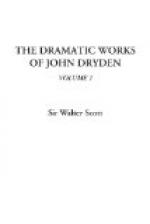Dryden had, however, made his bargain, and was compelled to fulfil it the best he might. As his last tragic piece, the “Indian Emperor,” had been eminently successful, he was next to show the public, that his talents were not limited to the buskin; and accordingly, late in 1667, was represented the “Maiden Queen,” a tragi-comedy, in which, although there is a comic plot separate from the tragic design, our author boasts to have retained all that regularity and symmetry of parts which the dramatic laws require. The tragic scenes of the “Maiden Queen” were deservedly censured, as falling beneath the “Indian Emperor.” They have neither the stately march of the heroic dialogue, nor, what we would be more pleased to have found in them, the truth of passion, and natural colouring, which characterised the old English drama. But the credit of the piece was redeemed by the comic part, which is a more light and airy representation of the fashionable and licentious manners of the time than Dryden could afterwards attain, excepting in “Marriage a la Mode.” The king, whose judgment on this subject was unquestionable graced the “Maiden Queen” with the title of his play; and Dryden insinuates that it would have been dedicated to him, had he had confidence to follow the practice of the French poets in like cases. At least, he avoided the solecism of inscribing the king’s own play to a subject; and, instead of a dedication, we have a preface, in which the sovereign’s favourable opinion of the piece is studiously insisted upon. Neither was the praise of Charles conferred without critical consideration; for he justly censured the concluding scene, in which Celadon and Florimel treat of their marriage in very light terms in presence of the Queen, who stands by, an idle spectator. This insult to Melpomene, and preference of her comic sister, our author acknowledges to be a fault, but seemingly only in deference to the royal opinion; for he instantly adds, that, in his own judgment, the scene was necessary to make the piece go off smartly, and was, in the estimation of good judges, the most diverting of the whole comedy.
Encouraged by the success of the “Maiden Queen,” Dryden proceeded to revive the “Wild Gallant;” and, in deference to his reputation, it seems now to have been more favourably received than at its first representation.
The “Maiden Queen” was followed by the “Tempest,” an alteration of Shakespeare’s play of the same name, in which Dryden assisted Sir William Davenant. It seems probable that Dryden furnished the language, and Davenant the plan of the new characters introduced. They do but little honour to his invention, although Dryden has highly extolled it in his preface. The idea of a counterpart to Shakespeare’s plot, by introducing a man who had never seen a woman, as a contrast to a woman who had never seen a man, and by furnishing Caliban with a sister monster, seems hardly worthy of the delight with which Dryden says he filled up the characters




